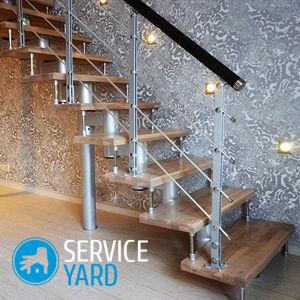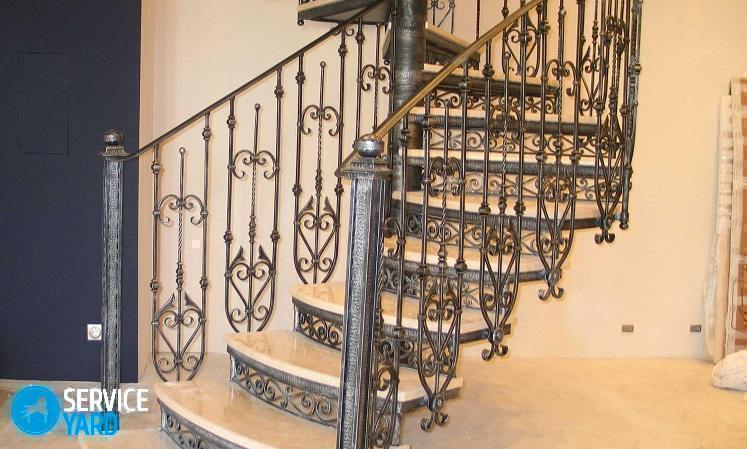How to make a railing for a staircase with your own hands from metal?

Railings are part of the staircase enclosure. They provide safe movement of stairs. Their distinctive feature is the large number of options for forms and materials. Some are simple, where safety and convenience are the main thing. There are railings that are decoration. This is especially true for structures located directly in the room. Topic of the article: how to make a railing for a staircase with your own hands from metal and wood.
to contents ↑Materials of manufacture
Railing can be made of such materials:
- Wood.
- Metal.
- Plastic.
- Concrete.
to contents ↑Important! If we are talking about self-production, then the best options are wood and metal.
DIY stair railing - requirements
Design designs may vary. It depends on the style in which the room is maintained and the taste preferences of the owner of the house. However, there are a number of basic rules that must be followed without fail:
- The minimum height of the fence is 0.9 m.
- Handrails should not be too wide and absolutely smooth.
- If the staircase adjoins one side to the wall, and the flight of stairs is narrow, then one protective structure is enough. For a wide flight of stairs you will need two fences.
- If there are children in the family, and the stairs are high and steep, you must take care of an additional low fence so that the child can safely walk the stairs.
to contents ↑Important! Do not forget to provide for the distance between the balusters. It should be such that the baby could not crawl between them. The best option is from 150 to 200 mm.
What is the protective structure made of?
Before you make the railing on the stairs, you need to know what such systems consist of:
- Handrail. This is the upper bar, which is located above the fence structure. The handrail is designed to be held during the descent and ascent. For this reason, it must be made monolithic and smooth.
- Balusters - racks attached to bowstrings or steps. They are set at a certain interval.
- Curbstones are powerful end racks at the end of a staircase. Handrails are fixed to them.
How to make a railing for a staircase with your own hands from metal?
We begin the review of the possibility of self-made stairs with a variant of metal. Here you will find this order of work.
Material selection
Such options are possible.
Aluminum
It is not easy to make an aluminum structure yourself. Most often, finished parts and fixtures for aluminum railings are sold. It is already easy to assemble a protective structure from finished parts. The main thing is to think over the design in advance and correctly calculate the number of different elements that will be required during operation.
Unfortunately, the performance of aluminum leaves much to be desired. It is deformed, scratched, and fades over time.
Chrome steel
Parts for such fences are also commercially available. It is important to correctly calculate and purchase exactly as many materials as you need. The chrome-plated product looks very beautiful and respectable.However, the coating will wear off soon enough. This is especially true of public spaces and public places.
Forged items
Hot forged parts are in most cases factory work. Making them yourself is quite difficult. If we are talking about making structures with our own hands, then the cold forging technique is most often used.
The advantages of forged railings are:
- Aesthetics.
- A large number of design solutions for all styles.
- Uniqueness - even if forging is carried out according to a standard drawing, there are no two absolutely identical forged products.
Important! There are also disadvantages: the high cost of products, the high complexity of the work, the need for special knowledge and tools.
Stainless steel
Beautiful, practical material with a noble, non-fading sheen. Stainless steel fencing is reliable and durable. Their installation will require skills in welding and cutting for metal.
Let us now consider the procedure for manufacturing the simplest railings from a metal profile.
Required Toolkit:
- Workwear set, protective welding mask.
- Welding machine, a set of electrodes to it.
- Angle grinder.
- Circles for cutting metal.
- Level.
- Metal rolling, metal profile.
Important! It is advisable to choose a profile of a small section so that it is easier to cut.
Work order
Decide on the parameters of future railings:
- Height.
- The interval between balusters.
Useful Tips:
- On the upper and lower steps will be installed pedestals, fixing the entire structure. The thickness of the pedestals should be greater than the balusters.
- The standard height of the railing is 0.95 m. However, the railing frame itself must be raised 10 cm above the steps. Approximately 5 cm goes to the handrail. Thus, the frame itself remains: 95-5-10 = 80 cm. So - cutting the metal profile into balusters and stands should be done at 80 cm.
- After that, the frame length is calculated for cutting the transverse upper and lower profiles.
- After the profile is cut into frame elements, it remains only to weld it. It is not necessary to grasp the elements tightly so that during marriage, mistakes or warping, you do not have to do double work.
- After the frame is welded, it remains to reinforce it by welding balusters after 10 cm.
Important! The thickness of the pedestals is twice that of the internal vertical jumpers.
If the geometry of the structure is maintained correctly, then you can proceed to the final welding of structural elements. Seams are welded from 2 sides for maximum strength.
Dressing
How can I decorate the railing with my own hands? Using a grinder, clean and polish all irregularities left after welding. It’s a good idea to decorate a metal fence welded on your own with purchased forged elements.
Important! Ornaments, patterns, floral motifs will greatly decorate the design. Handrails are best used with wood.
Dyeing
Before painting, coat the metal surface with a primer. It will protect the metal structure from corrosion. Use a special metal dye for painting.
to contents ↑Important! The color depends on your taste, but the most common option is black. To artificially age the metal and give it a noble appearance, patina is used.
Self-made wooden railing
Consider how to make a wooden railing for the stairs with your own hands.
Materials
The first stage is the choice of the material for the manufacture of the railing.
Pine
Pine wood is soft, has an affordable cost, so it is used in construction quite often. Due to the heterogeneous structure, when staining, the pine does not absorb the dye in the same way.
Important! Wood is well processed, tolerates temperature changes well.
Oak
Strong, durable, beautiful and respectable material. Oak wood is resistant to rot and parasite damage.
Important! The disadvantage is the high cost.
Birch
Beautiful, durable material with a high density, almost without knots. The birch massif is perfectly processed, but not without flaws:
- he is susceptible to putrefactive lesions;
- deformed;
- Cracks when temperature and humidity drop.
Beech
By strength, beech wood is close to oak. However, unlike oak, beech cracks on fibers at low humidity, which leads to damage to wooden products.
Main elements
As in the metal structure, the wooden railing consists of pedestals, balusters and handrails.
In a wooden structure, balusters play not only the role of supports, but at the same time they are decor. Often, glued timber is used for their manufacture, from which columns of various shapes are grinded.
It is possible to handle balusters on a milling or turning machine:
- In the first case, the patterns are obtained by screw, in the second - geometric.
- Manual cutting of balusters is a very time-consuming task. But at the same time we get truly unique products, the pride of the owners.
Important! It can be images of people or animals, geometric patterns, floral motifs.
How to make a fence for a staircase from flat balusters?
The easiest way to decorate the staircase with wooden elements is a design of flat balusters in which patterns are cut.
As with the calculation of the metal structure:
- The height of the flat patterned boards will be 80 cm.
- The thickness of the plank is 0.30-0.35 cm, and the width varies from 10 to 15 cm.
To give balusters a beautiful shape:
- They are cut out on a lathe or a jigsaw. Pre-make a template on paper.
- After the processing of the planks is finished, they are sanded with sandpaper and polished.
Important! Flat balusters are not attached to the steps, since the fence will be shaky and unreliable. Installation is made on the cross beam located 10 cm above the bowstring. The frame is thus formed by pedestals, a handrail and a lower beam.
The maximum interval through which the boards are fixed is 15 cm. In this case, 2 types of connections are used:
- On a metal stud.
- In the groove. Moreover, the depth of the groove is 2 cm. The length of the groove corresponds to the width of the baluster.
Important! We must not forget about the slope of the stairs. For this reason, the lower part of the baluster is flat, and the upper part is cut off in accordance with the angle of the staircase.
Handrails are attached to the slices.
The balusters are mounted on a metal stud if it is not possible to mount the transverse beam. In this case, there will be no interval between steps and planks. The height of the balusters will be 0.9 m. After the protective boards are mounted, you can attach a wooden handrail.
to contents ↑Important! The wood structure can be painted with stain, varnish or acrylic dye.
Stock footage
In this article, we examined the 2 most affordable options to make a railing for a staircase with your own hands from metal and wood. Which one should be preferred now - decide, taking into account the general design of the room and the materials used for its decoration.
- How to choose a vacuum cleaner taking into account the characteristics of the house and coatings?
- What to look for when choosing a water delivery
- How to quickly create comfort at home - tips for housewives
- How to choose the perfect TV - useful tips
- What to look for when choosing blinds
- What should be running shoes?
- What useful things can you buy in a hardware store
- Iphone 11 pro max review
- Than iPhone is better than Android smartphones






